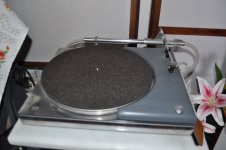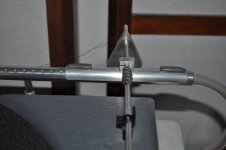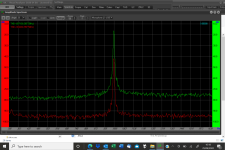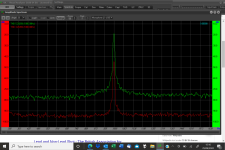Excellent cart behavior, straight design: congratulations
I like the idea of obtaining a V.E.M. closer to H.E.M. by keeping the (light) CW away from the pivot (others think differently).
Less convinced by the vertical articulation, as on every Cantus.
carlo
3d print: fused filament or lithography?
I like the idea of obtaining a V.E.M. closer to H.E.M. by keeping the (light) CW away from the pivot (others think differently).
Less convinced by the vertical articulation, as on every Cantus.
carlo
3d print: fused filament or lithography?
V.E.M ? H.E.M ?
I can only guess that this is something related to V=vertical and H= horizontal.
this is fused filament. As I am new to 3D printing I used PLA which is said to be the easiest printing filament. the only drawback is you can‘t hide the layering so easy. Prints of ABS can easily smoothed in acetone vapors. this is not possible in PLA. If you want a smooth finish you have to sand it. But at the moment I am fine with it just like it is. May be I will reprint parts of it later in ABS
I can only guess that this is something related to V=vertical and H= horizontal.
this is fused filament. As I am new to 3D printing I used PLA which is said to be the easiest printing filament. the only drawback is you can‘t hide the layering so easy. Prints of ABS can easily smoothed in acetone vapors. this is not possible in PLA. If you want a smooth finish you have to sand it. But at the moment I am fine with it just like it is. May be I will reprint parts of it later in ABS
yes - Vertical vs Horizontal effective mass - Don't know if it's the right acronym, but is shorter...
Some years ago I've designed a 3D printed pivoted linear tonearm (the 3DTOY- on "angling for 90°" thread). Friends told me that lithography is far sturdier than PLA but never tried.
My 3DTOY was immersed in white glue, with some improvement.
c
Some years ago I've designed a 3D printed pivoted linear tonearm (the 3DTOY- on "angling for 90°" thread). Friends told me that lithography is far sturdier than PLA but never tried.
My 3DTOY was immersed in white glue, with some improvement.
c
Niffy, a few years ago you wrote about the importance of mechanical impedance, z = density*speed of sound, for the choice of platter material (#2818). I am using a 1" graphite platter over a 3" lump of cast iron; graphite has very close to the same z as a vinyl record. It sounds very good indeed, providing independent validation of the use of z as a criterion.
I guess you did this for damping but the weight will have some effect as well. it is definitely interesting. My experience when i do something similar on similar arm parts is that it sounds clean but dull and the measurement changes from a sharp spike which shows artefacts to a wider spike which masks them.Hi friends. Guess from three times why I did this, namely, I placed a special mastic in some parts of the tonearm?
Here first attached is a measurement of my current set up 1416 with no damping of any mobile parts, just very stiff and light parts. if i damp those parts it masks what is happening see 1414, so i find that damping is very critcal and sometimes misleading. Do you measure your results as well as listen?
M
Attachments
Mike, I'm glad I'm finding a soul mate, I use Google to translate one language into another, so unbalanced actions are possible. Yes, I completely agree with you that the damping of one spectrum interferes with another, but our task is to reveal the subtleties of this process. Do you agree with me that the vinyl player is a resonant instrument in every way? We are with you and other people who are passionate about this process, we only find and reveal these subtleties. For fun, of course.
In this case, I wanted to remove the sound of air, which is certainly present in this, this is air pressure. You will probably laugh, but I record the analog sound of Vinyl on a video tape recorder, as a carrier of analog sound, and its technical characteristics such as 15Hz-35kHz at 0 dB recording can cause many feelings in the head of an audiophile. 
Of course, the air bearing is the most ideal in the case of a parallel tonearm, but it also has its drawbacks, and this is the sound of a compressor, in order to suppress this sound of a compressor, I use two receivers (ordinary water filters), at the beginning of the air hose and at the end, this works . In the presence of a good vinyl corrector, all artifacts are reduced to a minimum, that is, the musical signal is given the cleanest. Subjectively.
Not just weight or mass, but horizontal mass, and if we imagine what a sound track milled with a cutter is, we can find that the horizontal mass of the tonearm is very important, because the tonearm stylus works like a hammer in relation to a heavy anvil and what a big difference of such masses, the needle will track the groove of the record better and better.I guess you did this for damping but the weight will have some effect as well.
Hi Havun, I am happy also to see your inputs, there is a lot to learn, and both learning and listening to the results is fun.Mike, I'm glad I'm finding a soul mate, I use Google to translate one language into another, so unbalanced actions are possible. Yes, I completely agree with you that the damping of one spectrum interferes with another, but our task is to reveal the subtleties of this process. Do you agree with me that the vinyl player is a resonant instrument in every way? We are with you and other people who are passionate about this process, we only find and reveal these subtleties. For fun, of course.
From my listening, learning and experimentations so far I think more about all vibrations, probably better thought of as micro- vibrations, whether they are resonant or not.
Vibrations are a very complex subject!
I can see the air bearing has advantages in respect of low friction, however air is compressible and with an air bearing the path for vibration energy to be dissipated is intereupted and everything on the stylus side of the air bearing is flexibly mounted, whereas for my type of arm it is rigidly mounted, i dont know which is better as i have only ver worked on the rigid type................!Of course, the air bearing is the most ideal in the case of a parallel tonearm, but it also has its drawbacks, and this is the sound of a compressor, in order to suppress this sound of a compressor, I use two receivers (ordinary water filters), at the beginning of the air hose and at the end, this works . In the presence of a good vinyl corrector, all artifacts are reduced to a minimum, that is, the musical signal is given the cleanest. Subjectively.
M
Я все это знаю, но вынужден вас разочаровать, воздушный подшипник используется на сверхточных шпинделях и на самых высоких скоростях.Я вижу, что воздушный подшипник имеет преимущества в отношении низкого трения, однако воздух сжимаем, и с воздушным подшипником путь для рассеивания энергии вибрации перекрывается, и все со стороны иглы воздушного подшипника установлено гибко, тогда как для моего тип рычага он жестко установлен, я не знаю, какой лучше, так как я работал только с жестким типом ................!
М
Ведь воздушный подшипник это совсем не то, что вы описали, а это тонкая воздушная пленка в несколько микрон и регулируется она подачей воздуха от компрессора.
Но самое главное преимущество такой системы в том, что она полностью отделяет тонарм от основного стола с его диском, мотором, приводом от мотора к диску и прочими «прелестями» в плохом смысле винилового проигрывателя.
I know all this, but I have to disappoint you, the air bearing is used on ultra-precise spindles and at the highest speeds.
After all, an air bearing is not at all what you described, but it is a thin air film of several microns and it is regulated by the air supply from the compressor.
But the most important advantage of such a system is that it completely separates the tonearm from the main table with its disc, motor, drive from the motor to the disc and other “charms” in the bad sense of a vinyl player.
According to the website, this product can be a game changer, particularly for parallel tracking. Unfortunately, the price is 600,000 yen ($4,600 USD). Yikes! I think those 6 figure uber turntables should just give out such device as a freebie!
Besides the Nakamichi turntables, I'm surprised no one else thought of accessories like this. I do know a Frank Schroeder designed turntable had deliberate smaller diameter spindle at the bottom portion to allow room to shift the record for concentricity. Other than that, the so called "high end" world has not spent much time on a device like this except making bigger and heavier and brighter platters. Shouldn't turntable spindles be machined independently from the bearing shaft so they can be swapped out with different diameters and length?
Besides the Nakamichi turntables, I'm surprised no one else thought of accessories like this. I do know a Frank Schroeder designed turntable had deliberate smaller diameter spindle at the bottom portion to allow room to shift the record for concentricity. Other than that, the so called "high end" world has not spent much time on a device like this except making bigger and heavier and brighter platters. Shouldn't turntable spindles be machined independently from the bearing shaft so they can be swapped out with different diameters and length?
Just ask yourself why they use a linear arm when recording.According to the website, this product can be a game changer, particularly for parallel tracking. Unfortunately, the price is 600,000 yen ($4,600 USD). Yikes! I think those 6 figure uber turntables should just give out such device as a freebie!
Besides the Nakamichi turntables, I'm surprised no one else thought of accessories like this. I do know a Frank Schroeder designed turntable had deliberate smaller diameter spindle at the bottom portion to allow room to shift the record for concentricity. Other than that, the so called "high end" world has not spent much time on a device like this except making bigger and heavier and brighter platters. Shouldn't turntable spindles be machined independently from the bearing shaft so they can be swapped out with different diameters and length?
But in that case, this tonearm is "active", and our business is to use the same tonearm, only "passive".
That is, tracking the recording track with the same accuracy.
Only accuracy is important. And everything else is fairy tales and legends.
Hi esis,Niffy, a few years ago you wrote about the importance of mechanical impedance, z = density*speed of sound, for the choice of platter material (#2818). I am using a 1" graphite platter over a 3" lump of cast iron; graphite has very close to the same z as a vinyl record. It sounds very good indeed, providing independent validation of the use of z as a criterion.
I believe that Nottingham Analogue uses/used graphite as the top layer of their platters. The only time I heard a Nottingham turntable it was in the Music First room at a hifi show. It took the sound of the show award from me. Many years ago one of my audio buddies did a massively OTT rebuild/upgrade of a Garrard turntable. He used a Nottingham Analogue graphite platter instead of its horrible rubber mat. It is one of the best decks I have ever heard.
So from my experience I would have to agree that graphite is an excellent material. I'll have to take your word on it having a similar mechanical impedance to vinyl as it's not one I have in my database. A 3" slab of cast iron is probably going to be rather inert and be unlikely to ring, unlike many metal platters. If it's solid it's going to weigh over 40kg. I hope you have a monster of a bearing.
Niffy
Hello Niffy.
Interesting co-incidences. I was TT shopping when I heard a NA Spacedeck, and after talking to Tom I bought one of the last Mentors, since upgraded to near-Dais standard. Guess where the graphite over iron idea came from when I decided to go air DIY - that and a big New Way air thrust bushing for full 3-D air.
The cast iron platter rings at 5ooHz, the graphite mat at 2KHz, the assembly dead as a tomb. I've been reading your tonearm studies for years now and finally decided to go DIY air for the tonearm too. Just ironing out the wrinkles now - another brute force solution, no finesse, just going from F=ma to wherever that leads.
Sounding good so far, but still some kinks. Super's work has been most instructive too.
Interesting co-incidences. I was TT shopping when I heard a NA Spacedeck, and after talking to Tom I bought one of the last Mentors, since upgraded to near-Dais standard. Guess where the graphite over iron idea came from when I decided to go air DIY - that and a big New Way air thrust bushing for full 3-D air.
The cast iron platter rings at 5ooHz, the graphite mat at 2KHz, the assembly dead as a tomb. I've been reading your tonearm studies for years now and finally decided to go DIY air for the tonearm too. Just ironing out the wrinkles now - another brute force solution, no finesse, just going from F=ma to wherever that leads.
Sounding good so far, but still some kinks. Super's work has been most instructive too.
Unfortunately (or fortunately, depending on your point of view) this is not the case.But the most important advantage of such a system is that it completely separates the tonearm from the main table with its disc, motor, drive from the motor to the disc and other “charms” in the bad sense of a vinyl player.
The thin layer of air in the gap acts as a spring. One of the specifications of an air bearing is its stiffness, stiffness is a property of springs. In combination with the mass of the carriage and the damping the air supplies you will have a spring-mass-damper system (SMD). All SMDs will have a resonant frequency. Where this falls will be dependant on many factors but it will likely fall within the audio band.
Below resonance the carriage will be affectively coupled to the rail.
At resonance there will be a peek in the response. The reason a silicon damping trough is added to most air bearing arms is to control this resonance. It is not to control "the tail wagging the dog" due to high lateral mass as many assume.
Above resonance the carriage will start to decouple from the rail at around 12dB per octave.
In my opinion it is much better to have the arm as solidly coupled as possible in as many of the degrees of freedom as possible, 4 of the 6, leaving 2 decoupled to allow for vertical and lateral movement of the arm.
This is because by far the greatest source of vibration in a record player is due to the stylus groove interface. Unlike bearing, motor and environmental noise this cannot be engineered away. By coupling the arm to the base you are giving this vibrational energy a path to dissipate through. You are also increasing the mass and rigidity of the system in the 4 coupled degrees of freedom.
The main advantage of an air bearing is its low friction.
The main disadvantage of an air bearing is that the air gap is a spring.
Niffy
Last edited:
- Home
- Source & Line
- Analogue Source
- DIY linear tonearm



